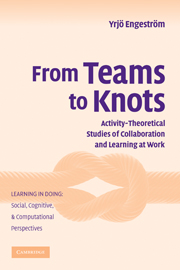Book contents
- Frontmatter
- Contents
- Series Foreword
- Preface
- 1 Teams and the Transformation of Work
- 2 Disturbance Management and Masking in a Television Production Team
- 3 Teamwork between Adversaries: Coordination, Cooperation, and Communication in a Court Trial
- 4 Displacement and Innovation in Primary Care Medical Teams
- 5 Crossing Boundaries in Teacher Teams
- 6 Knowledge Creation in Industrial Work Teams
- 7 Teams, Infrastructures, and Social Capital
- 8 From Iron Cages to Webs on the Wind
- 9 Knotworking and Agency in Fluid Organizational Fields
- References
- Author Index
- Subject Index
- Titles in the series
8 - From Iron Cages to Webs on the Wind
Published online by Cambridge University Press: 05 June 2012
- Frontmatter
- Contents
- Series Foreword
- Preface
- 1 Teams and the Transformation of Work
- 2 Disturbance Management and Masking in a Television Production Team
- 3 Teamwork between Adversaries: Coordination, Cooperation, and Communication in a Court Trial
- 4 Displacement and Innovation in Primary Care Medical Teams
- 5 Crossing Boundaries in Teacher Teams
- 6 Knowledge Creation in Industrial Work Teams
- 7 Teams, Infrastructures, and Social Capital
- 8 From Iron Cages to Webs on the Wind
- 9 Knotworking and Agency in Fluid Organizational Fields
- References
- Author Index
- Subject Index
- Titles in the series
Summary
The six case studies presented in the preceding chapters yield a contradictory picture of teams in work organizations. On the one hand, a close analysis of teams in action often reveals moments of innovative potential and productive problem solving. On the other hand, these moments seem to be just that: passing moments with little evidence of sustainability and durability.
Creative moments seem to be typical of new teams still searching for their routines. When teams persist as stable units, their very durability seems to destroy innovativeness and the capacity to learn, at least in the case of the television production team analyzed in Chapter 2. What is perhaps more troubling is the finding, well illustrated by the machinist team analyzed in Chapter 6, that when reasonably mature teams attempt to create innovative solutions, they easily end up in conflict with the overall managerial strategy and rules of the larger organization, which can turn their innovations into frustration.
The literature on work teams is saturated with questionable success stories and normative guidelines for management. Against this background, it is refreshing to read critical studies of teams. However, as I will show, critical team studies tend to fall into the opposite trap of condemning teams as a management conspiracy. In this chapter, I will try to take the contradictory character of teams seriously, seeking a more dialectical and forward-looking approach, with an emphasis on implications for learning at work.
- Type
- Chapter
- Information
- From Teams to KnotsActivity-Theoretical Studies of Collaboration and Learning at Work, pp. 182 - 198Publisher: Cambridge University PressPrint publication year: 2008

